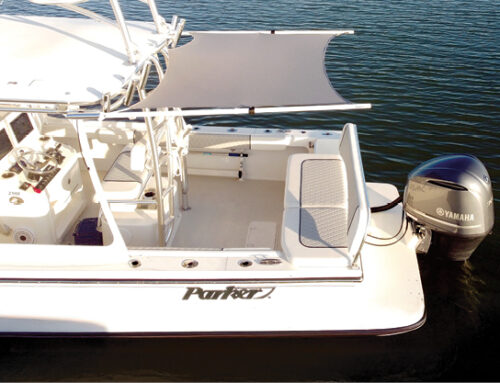Full coverage
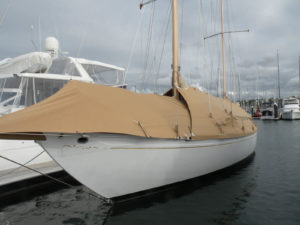
The owner of this yacht wanted entrance points on both sides with the full cover in place, and removable sections near the cockpit area. David’s Custom Trimmers of Queensland, Australia, used more than 85 yards of fabric, 43 zips and 10 yards of felt-like carpet as rub strips on this cover that included nine sections.
The cover won an outstanding achievement award in the 2014 MFA Fabrication Excellence Awards.
Tips and trends in travel and mooring covers.
Every boat owner wants to be on the water as much as possible. But even the most avid mariners need to make the occasional trip to shore, and when they do, they need to protect their craft from the elements. Good mooring and travel covers protect the finish, upholstery and interior/exterior environments of boats. A custom cover is nearly always the right choice to ensure a good fit, proper ventilation and maximum protection.
Securing covers
A cover is only as good as its fasteners. Wind generated by storms and highway travel will do its best to undo the fastening of a cover. Using the proper equipment is essential.
Charlie Kees, owner of Mister Sew-N-Sew Custom Boat Canvas, Waterford, N.Y., equips his boat covers with fasteners he knows he can rely on. “I do not advise customers to use mooring covers as travel covers,” he says, “but [many customers] do. I put tabs on the sides of my covers just in case some of the snaps loosen when people are going 70 [miles an hour] on the highway. That way they can latch down the mooring cover and not have their cover fly off onto someone’s windshield.”
“Here in Florida, because of the storms, we like to have a tie-off option [for mooring covers],” says Marguerite Langey, co-owner and fabricator at Bambi’s Boat Works of in Merritt Island, Fla. “This provides added security from the wind.”
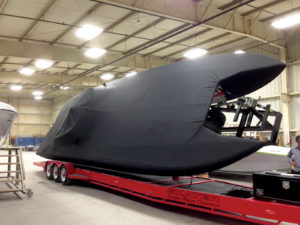
This travel cover by Canvas Innovations, Holland, Mich., was “extremely custom.” Every curve and surface was patterned so the cover would form to the boat for traveling. It took 85-yards of Soft Touch fabric, which included multiple sewn-in vents to help release air so the cover didn’t balloon during travel. The cover won an award of excellence in the 2015 MFA Fabrication Excellence Awards. Photo: Kenny Degroot.
Langey has also used a unique suction device for some of her travel and mooring covers. “[The device] has a bungee attached to it that you lace through a grommet in the hem,” she says. “The suction cup then adheres to the side of the boat. The cups are about 4 inches in diameter and hold very well. For someone who has a boat on the lift, it’s a way to secure it while they put it on so it doesn’t blow off while they are securing it.”
Both Kees and Langey commonly use snaps and drawstrings to secure their covers. Kees has made mooring covers with tie-arounds that cinch around the boat in order to avoid drilling holes in a boat to attach hardware for snaps. “I’ll use a drawstring, especially when I’m working on a show boat or a boat with a really nice finish on the paint,” he says. “We also sometimes use straps that may go underneath the boat in order to tie the mooring cover to the trailer, under the hull, and to the other side of the boat.”
It’s all about the fabric
Marine fabricators across the country largely rely on Sunbrella fabric for their travel and mooring covers. Kathryn Maisto of Fairwinds Canvas in Racine, Wis., says Sunbrella fabrics are the standard choice for their boat covers. “Ninety-five percent of the time, we make [our covers] out of Sunbrella,” she says.
Langey also relies heavily on Sunbrella fabrics. “Customers are looking for something that is going to keep sun, rain and weather off of their upholstery,” she says. “They want a cloth that will keep heat from building up under the cover, something that is going to breathe. We almost always use a light-colored
Sunbrella fabric that reflects heat and provides the coverage qualities the customer wants.”
Sunbrella is also Kees’ choice for covers. “Whether it is for a bimini on a boat, a sun shade or a mooring cover, we use Sunbrella,” he says. “It keeps leaves, twigs and pollen out; it keeps the rain off and the squirrels out; it breathes. Even if a little rain does get under the cover, it will evaporate because Sunbrella breathes.”
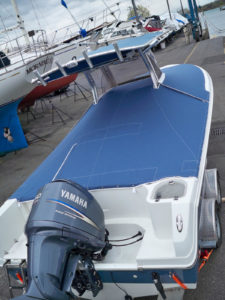
This two-piece travel cockpit cover by Lake Shore Boat Top Company Inc., Detroit, Mich., zips and attaches onto a telephone booth enclosure. The front cover is supported by an adjustable tent pole and is snapped all the way around the boat. The rear cover attaches over the console to protect instruments, and zips into the front travel cockpit cover, and snaps around the boat. The cover won an award of excellence in the 2013 MFA Fabrication Excellence Awards.
Brad Schmeets of Fine Line Canvas and Upholstery in Colorado Springs, Colo., uses his share of Sunbrella, but he also relies on Top Gun acrylic-coated polyester, manufactured by Marlen Textiles, and K Tex fabric, manufactured by Keyston Bros. In the past, many fabricators were using webbing and polywebbing for reinforcement on covers,” he says. “I’ve found the webbing breaks down, however, and I wanted something of higher quality. I now use Top Gun fabric and K Tex for my 2-inch reinforcements because they just last longer. You can’t tear it. It won’t rub through. It makes a good quality cover, and it doesn’t stretch a lot, so the cover stays where it’s supposed to. Vinyl will stretch and so does webbing.”
Schmeets reinforces all areas that experience friction, including areas where a cover will contact seat backs and windshields.
Unique technology
The fabric for covers might not have changed much over the years, but some new technology has made its way into the sewing room. Langey has worked with solar-powered vents that are sewn directly into the fabric of mooring covers. “Somebody came to me recently with some vents that are solar-powered that can be installed into the cover,” she says. “It has a solar panel on top. It’s some sort of plastic, and it has a gasket that goes on the underside of the canvas, and it’s like a little hood. It’s about 5 or 6 inches in diameter, and it has a little fan built into it. The solar panel is in the top of the hood of the device itself.”
Maisto also has worked with solar vents, but has found that the price point can be challenging to work with. “The vents are good,” she says, “but the problem we find is that when you add nicer accessories, it bumps the price up. When you get higher prices, we find people go to a production instead of a custom cover.”
A technology more integral to cover manufacturing is the development of UV-resistant threads. SolarFix, from Quality Thread & Notions Co., and W.L. Gore and Associates’ Gore Tenara are threads made of polytetrafluoroethylene (PTFE) instead of the more traditional nylon. The threads are extremely resistant to harmful UV rays and chemical exposure. Featuring mildew resistance and easy cleaning, these threads are useful for boat cover projects. Langey also uses SolarFix for other marine applications, including cushions.
“These threads won’t rot,” says Langey, “so the customer isn’t going to have to pay for a re-stitch of their cover. With old nylon threads, they break down after three or four years. You can also bleach them, and they are very user friendly. They don’t ‘work’ the sewing machine as much.”
Maisto says her shop has always used Gore Tenara thread for covers. “We don’t want our stuff coming back for repairs, so we use the best products we can find,” she says. “[The thread] is more expensive, but we think it is a must.”
Final touches
It is the small things that often make the biggest difference. With travel and mooring covers, paying attention to detail can help make your custom covers outshine standard ones.
Kees makes sure his tie-down attachments meet his quality standards. “When grommets are sewn into the seam,” he says, “I want to make sure I use the right hardware. I use nonferrous metals like stainless steel or brass for my grommets. I don’t want anything to rust. Rust will transfer to your material and leave a telltale rust mark on your cover.”
Schmeets makes sure his custom covers have a custom fit. “We make them fit tight,” he says, “because if you travel with a loose cover, it will blow up like a balloon on the road.” He also includes customized poles with his covers to keep tension consistent throughout the boat.
From choosing more durable thread to selecting longer-lasting reinforcement material, marine fabricators continue to hone their customization skills on travel and mooring covers.
Jake Kulju is a freelance writer from Shafer, Minn.
-
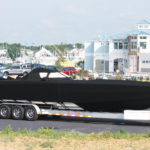
- This cover is made in two sections—a forward section, which includes the forward deck of the boat, free board and the forward hull section. The aft section comprises the canopy cover and aft deck, air-intake covers, rear view mirror covers and side freeboard. Canvas Experts of Ocean City, Md., won the award of distinction for this project in the 2014 MFA Fabrication Excellence Awards.
-
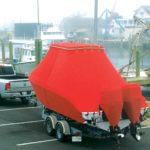
- Dubbed “Little Red Riding Hood,” this cover is a four-part, full-cover system. The first part is the top, the second part is the bow and pulpit area ending at the midpoint of the boat. Part 3 is the midpoint to the transom area, and Part 4 is the engine covers. Canvas Experts of Ocean City, Md., won an outstanding achievement award for this project in the 2014 MFA Fabrication Excellence Awards.
-
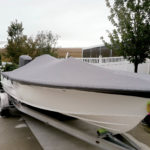
- This full summer cover by SeaCanvas, Egg Harbor Township, N.J., was designed to protect varnished wood from UV damage. The challenge was keeping the cover low profile so it could be used for short distance road travel. The cover won an outstanding achievement award in the 2013 MFA Fabrication Excellence Awards.
-
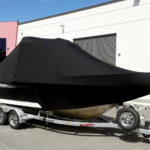
- This travel/storage cover by Prestige Marine Trimmers, Wangara, Perth, Australia, is custom-fitted to provide protection around the front of the hull. A tensioning rope around the bottom provides a tight fit to prevent movement when towing. The cover won an outstanding achievement award in the 2015 MFA Fabrication Excellence Awards.
 TEXTILES.ORG
TEXTILES.ORG 




